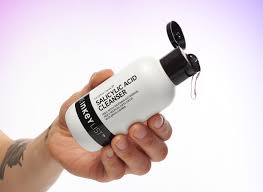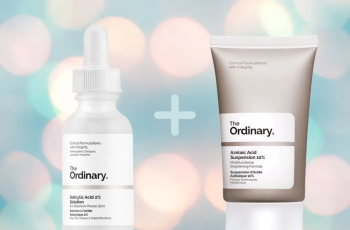
.webp)
.webp)
.webp)
Can You Use Salicylic Acid Cleansers with Retinol? Here’s What You Need to Know
.webp)
.webp)
Salicylic acid and retinol are two powerhouse skincare ingredients. They offer visible improvements for acne, aging, and uneven texture. However, they’re both potent and must be used with care to avoid irritation.
.webp)
.webp)
.webp)
Trying to combine them in your routine can be tempting, especially if you’re dealing with breakouts or persistent acne. But using them together the wrong way can do more harm than good.
.webp)
.webp)
Today, we’ll explore how to safely incorporate salicylic acid cleansers and retinol in your routine without compromising your skin’s health. Let’s break it down step-by-step.
.webp)
.webp)
.webp)
Understanding Salicylic Acid
.webp)
.webp)
Salicylic acid is a beta hydroxy acid (BHA). It’s oil-soluble, which means it can go deep into your pores. This makes it especially effective for oily or acne-prone skin.
.webp)
.webp)
.webp)
It works by exfoliating inside the pores, removing dirt, oil, and dead skin cells. This helps unclog pores and prevent blackheads and whiteheads from forming.
.webp)
.webp)
Salicylic acid also has anti-inflammatory properties. This makes it useful for calming redness and active breakouts. It’s gentle enough to use in cleansers, yet powerful when used consistently.
.webp)
.webp)
.webp)
What Does Retinol Do?
.webp)
.webp)
Retinol, a form of vitamin A, is one of the most studied skincare ingredients. It boosts collagen production and speeds up skin cell turnover. This helps reduce signs of aging and fade hyperpigmentation.
.webp)
.webp)
.webp)
It can also improve skin texture, reduce fine lines, and unclog pores. Over time, it makes skin look smoother, more even-toned, and youthful. But it can also be irritating when first introduced.
.webp)
.webp)
Retinol may cause redness, peeling, and dryness, especially if you’re using other strong actives. That’s why it’s important to introduce it slowly and avoid layering it with other harsh ingredients.
.webp)
.webp)
.webp)
Can You Use Salicylic Acid and Retinol Together?
.webp)
.webp)
Yes, but with precautions. Combining these ingredients can be effective, but only if you use them at the right time and in the right way. Otherwise, you risk over-exfoliating your skin.
.webp)
.webp)
.webp)
Using them both in one routine is not ideal. Doing so can strip your skin’s protective barrier, cause dryness, and increase sensitivity. Instead, space them out to avoid irritation.
.webp)
.webp)
A better approach is to use salicylic acid in the morning and retinol at night. This separation allows your skin to benefit from both while minimizing the risk of side effects.
.webp)
.webp)
.webp)
How Long Should You Wait Between Salicylic Acid and Retinol?
.webp)
.webp)
If you use a salicylic acid cleanser in your routine, wait about 30 minutes before applying retinol. This gives your skin time to balance its pH levels and avoid reactivity.
.webp)
.webp)
.webp)
Cleansers don’t stay on the skin for long, so they’re less likely to clash with retinol. Still, it’s best to let your skin rest between active steps to reduce stress and irritation.
.webp)
.webp)
Avoid using a salicylic acid serum followed by a retinol product in the same routine. That combination can be too strong and may result in redness, flaking, or breakouts.
.webp)
.webp)
.webp)
Best Cleansers to Use with Retinol
.webp)
.webp)
If you’re using retinol, choose a gentle cleanser that won’t strip your skin. Look for cream or gel-based cleansers that are non-foaming and free from sulfates or alcohol.
.webp)
.webp)
.webp)
Ingredients like hyaluronic acid, glycerin, and ceramides can help maintain hydration. These pair well with retinol, which is known to cause dryness, especially when you first start using it.
.webp)
.webp)
If your skin is oily or acne-prone, a mild salicylic acid cleanser can still be a good option. Just make sure it’s not overly drying and always follow up with a soothing moisturizer.
.webp)
.webp)
.webp)
Can You Use a Salicylic Acid Cleanser with Tretinoin?
.webp)
.webp)
Generally, no. Tretinoin is a prescription-strength retinoid that’s much stronger than over-the-counter retinol. Combining it with salicylic acid can overwhelm the skin.
.webp)
.webp)
.webp)
Unless directed by your dermatologist, avoid using any product with salicylic acid while using tretinoin. Even if your skin feels fine, irritation can develop over time with continued use.
.webp)
.webp)
Focus on following your dermatologist’s guidance. Once your skin has adjusted and your acne is under control, you can reintroduce other active ingredients as advised.
.webp)
.webp)
.webp)
How to Safely Incorporate Salicylic Acid and Retinol in Your Routine
.webp)
.webp)
The safest and most effective method is alternating their use. This allows your skin time to recover and prevents over-exfoliation. Here’s how to do it:
.webp)
.webp)
.webp)
Use a salicylic acid cleanser in the morning.
.webp)
.webp)
Follow it with a gentle serum, moisturizer, and sunscreen.
.webp)
.webp)
.webp)
In the evening, apply retinol to clean, dry skin.
.webp)
.webp)
Keep your skin hydrated with a nourishing night cream or oil.
.webp)
.webp)
.webp)
Alternatively, you can use salicylic acid on nights when you’re not using retinol. This way, you’re still addressing acne and congestion without layering two strong actives.
.webp)
.webp)
Can You Use Salicylic Acid and Retinol in the Same Routine?
.webp)
.webp)
.webp)
It’s not recommended. Using both in the same routine can strip your skin’s natural oils and disrupt your moisture barrier. This can trigger redness, dryness, and even more breakouts.
.webp)
.webp)
Your skin may try to compensate by producing more oil, which can lead to clogged pores and dullness. Plus, when the barrier is damaged, other skincare ingredients may not work as well.
.webp)
.webp)
.webp)
To protect your skin, alternate usage or space them out. Don’t mix high concentrations of both unless you have a product formulated to do so—and have been advised by a professional.
.webp)
.webp)
Can You Use Salicylic Acid in the Morning?
.webp)
.webp)
.webp)
Yes, salicylic acid works well in morning routines. It clears away excess oil, reduces overnight buildup, and preps the skin for the day ahead.
.webp)
.webp)
It exfoliates gently and clears the pores, leaving your skin smooth and ready for other skincare products or makeup. For oily skin types, it also helps control shine throughout the day.
.webp)
.webp)
.webp)
Because it increases sun sensitivity, always follow up with a broad-spectrum sunscreen of SPF 30 or higher. UV protection is a must when using any exfoliating acids.
.webp)
.webp)
Tips for Using Salicylic Acid and Retinol Safely
.webp)
.webp)
.webp)
Here are a few best practices to make the most of these ingredients:
.webp)
.webp)
Start Slow – Introduce each product separately before combining in a routine.
.webp)
.webp)
.webp)
Alternate Days – Use salicylic acid on some days and retinol on others.
Hydrate Generously – Use hydrating serums and moisturizers to support your skin barrier.
Patch Test – Always test new products on a small area before full application.
Use Sunscreen – Both actives can increase sun sensitivity, so SPF is essential.
Listen to Your Skin – If you notice flaking, stinging, or breakouts, reduce frequency or pause use.
Should You Avoid Salicylic Acid and Retinol If You Have Sensitive Skin?
Yes, sensitive skin types should be extra cautious with these actives. Introduce one ingredient at a time and use lower concentrations. Monitor how your skin reacts before adding the other.
Look for formulations that combine soothing ingredients like aloe vera, centella asiatica, or niacinamide to reduce the chance of irritation.
If your skin becomes red, flaky, or sore, stop using both and allow your skin to recover. Then consult with a dermatologist to find a more suitable routine.
Final Thoughts
Salicylic acid and retinol are powerful tools for clear, glowing skin—but only when used correctly. If you’re considering adding both to your routine, the key is moderation, timing, and listening to your skin.
Use a salicylic acid cleanser in the morning and retinol at night. Or alternate days to give your skin the benefit of both without irritation. Skip layering them together unless advised by a skincare expert.
And never forget to use SPF daily. Both ingredients can leave your skin vulnerable to sun damage. Protecting your skin will ensure you get the most from your products without unwanted side effects.
Still have questions? Join us on Instagram @Procoal for skincare tips, product recommendations, and answers from our team of experts.



